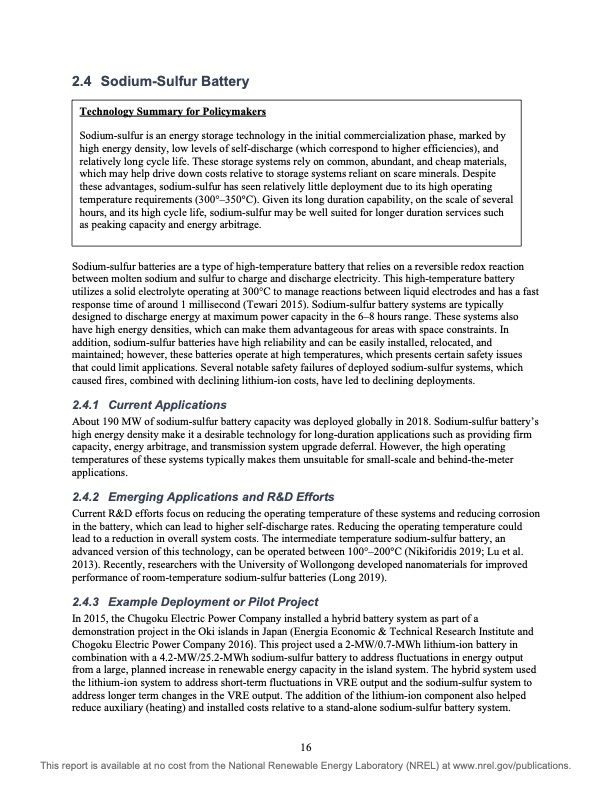
PDF Publication Title:
Text from PDF Page: 023
2.4 Sodium-SulfurBattery Technology Summary for Policymakers Sodium-sulfur is an energy storage technology in the initial commercialization phase, marked by high energy density, low levels of self-discharge (which correspond to higher efficiencies), and relatively long cycle life. These storage systems rely on common, abundant, and cheap materials, which may help drive down costs relative to storage systems reliant on scare minerals. Despite these advantages, sodium-sulfur has seen relatively little deployment due to its high operating temperature requirements (300°–350°C). Given its long duration capability, on the scale of several hours, and its high cycle life, sodium-sulfur may be well suited for longer duration services such as peaking capacity and energy arbitrage. Sodium-sulfur batteries are a type of high-temperature battery that relies on a reversible redox reaction between molten sodium and sulfur to charge and discharge electricity. This high-temperature battery utilizes a solid electrolyte operating at 300°C to manage reactions between liquid electrodes and has a fast response time of around 1 millisecond (Tewari 2015). Sodium-sulfur battery systems are typically designed to discharge energy at maximum power capacity in the 6–8 hours range. These systems also have high energy densities, which can make them advantageous for areas with space constraints. In addition, sodium-sulfur batteries have high reliability and can be easily installed, relocated, and maintained; however, these batteries operate at high temperatures, which presents certain safety issues that could limit applications. Several notable safety failures of deployed sodium-sulfur systems, which caused fires, combined with declining lithium-ion costs, have led to declining deployments. 2.4.1 Current Applications About 190 MW of sodium-sulfur battery capacity was deployed globally in 2018. Sodium-sulfur battery’s high energy density make it a desirable technology for long-duration applications such as providing firm capacity, energy arbitrage, and transmission system upgrade deferral. However, the high operating temperatures of these systems typically makes them unsuitable for small-scale and behind-the-meter applications. 2.4.2 Emerging Applications and R&D Efforts Current R&D efforts focus on reducing the operating temperature of these systems and reducing corrosion in the battery, which can lead to higher self-discharge rates. Reducing the operating temperature could lead to a reduction in overall system costs. The intermediate temperature sodium-sulfur battery, an advanced version of this technology, can be operated between 100°–200°C (Nikiforidis 2019; Lu et al. 2013). Recently, researchers with the University of Wollongong developed nanomaterials for improved performance of room-temperature sodium-sulfur batteries (Long 2019). 2.4.3 Example Deployment or Pilot Project In 2015, the Chugoku Electric Power Company installed a hybrid battery system as part of a demonstration project in the Oki islands in Japan (Energia Economic & Technical Research Institute and Chogoku Electric Power Company 2016). This project used a 2-MW/0.7-MWh lithium-ion battery in combination with a 4.2-MW/25.2-MWh sodium-sulfur battery to address fluctuations in energy output from a large, planned increase in renewable energy capacity in the island system. The hybrid system used the lithium-ion system to address short-term fluctuations in VRE output and the sodium-sulfur system to address longer term changes in the VRE output. The addition of the lithium-ion component also helped reduce auxiliary (heating) and installed costs relative to a stand-alone sodium-sulfur battery system. 16 This report is available at no cost from the National Renewable Energy Laboratory (NREL) at www.nrel.gov/publications.PDF Image | USAID GRID-SCALE ENERGY STORAGE TECHNOLOGIES PRIMER

PDF Search Title:
USAID GRID-SCALE ENERGY STORAGE TECHNOLOGIES PRIMEROriginal File Name Searched:
76097.pdfDIY PDF Search: Google It | Yahoo | Bing
Turbine and System Plans CAD CAM: Special for this month, any plans are $10,000 for complete Cad/Cam blueprints. License is for one build. Try before you buy a production license. More Info
Waste Heat Power Technology: Organic Rankine Cycle uses waste heat to make electricity, shaft horsepower and cooling. More Info
All Turbine and System Products: Infinity Turbine ORD systems, turbine generator sets, build plans and more to use your waste heat from 30C to 100C. More Info
CO2 Phase Change Demonstrator: CO2 goes supercritical at 30 C. This is a experimental platform which you can use to demonstrate phase change with low heat. Includes integration area for small CO2 turbine, static generator, and more. This can also be used for a GTL Gas to Liquids experimental platform. More Info
Introducing the Infinity Turbine Products Infinity Turbine develops and builds systems for making power from waste heat. It also is working on innovative strategies for storing, making, and deploying energy. More Info
Need Strategy? Use our Consulting and analyst services Infinity Turbine LLC is pleased to announce its consulting and analyst services. We have worked in the renewable energy industry as a researcher, developing sales and markets, along with may inventions and innovations. More Info
Made in USA with Global Energy Millennial Web Engine These pages were made with the Global Energy Web PDF Engine using Filemaker (Claris) software.
Sand Battery Sand and Paraffin for TES Thermo Energy Storage More Info
| CONTACT TEL: 608-238-6001 Email: greg@infinityturbine.com | RSS | AMP |